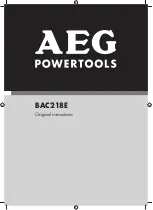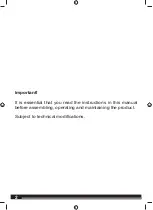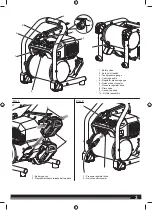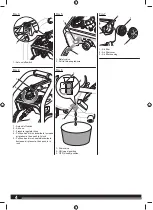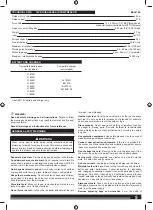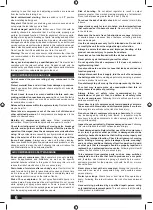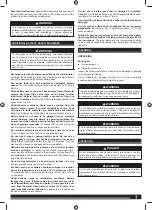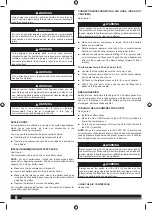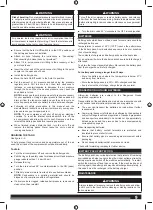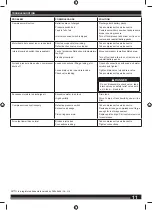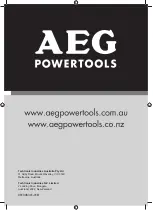
9
9
WARNING
Risk of bursting.
Do not adjust pressure regulator knob to result
in output pressure greater than marked maximum pressure of
DWWDFKPHQWDQGRUWKHLWHPEHLQJLQÀDWHG1HYHUXVHDWSUHVVXUH
greater than 8.3 bar (120 psi). Failure to heed this warning could
result in possible serious personal injury.
WARNING
Air powered tools may require more air consumption than this
air compressor is capable of providing. Check the tool manual to
avoid damage to the tool or risk of personal injury.
Ŷ
Ensure that the Auto On/Off switch is in the OFF position and
the battery packs are not installed.
Ŷ
Attach air hose following the instructions in “Connecting/
Disconnecting Air Hose (hose not provided)”.
Ŷ
Attach 1/4 in. quick-connect air fitting to the accessory or tool
you intend to use.
Ŷ
Insert the other end of the quick-connect air fitting to the quick
coupler on the open end of hose.
Ŷ
Install the battery packs.
Ŷ
Move the Auto On/Off switch to the Auto On position.
Ŷ
Set the amount of air pressure desired using the pressure
regulator knob. Pull the knob out, then turn clockwise to
increase or counterclockwise to decrease the air pressure
through the hose. When the desired pressure is set, push the
knob back in to lock.
NOTE:
Always use the minimum amount of pressure necessary
for your application. Using a higher pressure than needed will
drain air from the tank more rapidly, cause the unit to cycle on
more frequently, and reduce battery run time between charges.
Ŷ
Following all safety precautions in this manual and the
manufacturer’s instructions in the air tool manual, you may now
proceed to use your air-powered tool.
NOTE:
The air compressor will shut off during an electrical
overload. To reset the internal overload switch, turn off the
air compressor and allow the unit to cool. Remove and then
reinstall the battery packs before resuming operation.
Ŷ
When finished, always drain the tank, turn the unit off, and
remove the battery packs. Never leave the unit on and/or
running unattended.
DRAINING THE TANK
See
¿
gure
.
To help prevent tank corrosion and keep moisture out of the air
used, the air tank of the compressor should be drained daily.
To drain:
Ŷ
Turn the air compressor off and remove the battery packs.
Ŷ
Pull the ring on the safety valve to release air until tank pressure
gauge reads less than 1.4 bar (20 psi).
Ŷ
Release the ring.
Ŷ
7XUQ WKH GUDLQ YDOYHV FRXQWHUFORFNZLVH WR WKH 21 RSHQ
position.
Ŷ
Tilt tank to drain moisture from tank into a suitable container.
NOTE:
Condensate is a polluting material and should be
disposed of in compliance with local regulations.
Ŷ
If a drain valve is clogged, release all air pressure, remove and
clean valve, then reinstall.
WARNING
Turn off the air compressor, remove battery packs, and release
all air from the tank before servicing. Failure to depressurise tank
before attempting to remove valve could cause serious personal
injury.
Ŷ
7XUQWKHGUDLQYDOYHFORFNZLVHWRWKH2))FORVHGSRVLWLRQ
BATTERIES
Battery packs which have not been used for some time should be
recharged before use.
7HPSHUDWXUHVLQH[FHVVRI&)UHGXFHWKHSHUIRUPDQFH
of the battery pack. Avoid extended exposure to heat or sunshine
(risk of overheating).
The contacts of chargers and battery packs must be kept clean.
For an optimum life-time, the battery packs have to be fully charged,
after used.
To obtain the longest possible battery life remove the battery pack
from the charger once it is fully charged.
For battery pack storage longer than 30 days:
6WRUH WKH EDWWHU\ SDFN ZKHUH WKH WHPSHUDWXUH LV EHORZ &
and away from moisture.
Store the battery packs in a 30% - 50% charged condition.
Every six months of storage, charge the pack as normal.
TRANSPORTING LITHIUM BATTERIES
Lithium-ion batteries are subject to the Dangerous Goods
Legislation requirements.
Transportation of those batteries has to be done in accordance with
local, national and international provisions and regulations.
Ŷ
The user can transport the batteries by road without further
requirements.
Ŷ
Commercial transport of Lithium-Ion batteries by third parties is
subject to Dangerous Goods regulations. Transport preparation
and transport are exclusively to be carried out by appropriately.
trained persons and the process has to be accompanied by
corresponding experts.
When transporting batteries:
Ŷ
Ensure that battery contact terminals are protected and
insulated to prevent short circuit.
Ŷ
Ensure that battery pack is secured against movement within
packaging.
Ŷ
Do not transport batteries that are cracked or leak.
Check with forwarding company for further advice.
BATTERY PACK PROTECTION
The battery pack has overload protection that protects it from being
overloaded and helps to ensure long life. Under extreme stress the
battery electronics switch off the machine automatically. To restart,
switch the machine off and then on again. If the machine does not
start up again, the battery pack may have discharged completely. In
this case it must be recharged in the battery charger.
MAINTENANCE
WARNING
Always release all pressure, remove the battery packs, and allow
unit to cool to the touch before cleaning or making repairs on the
air compressor.
Содержание 6230329
Страница 1: ...BAC218E ...

